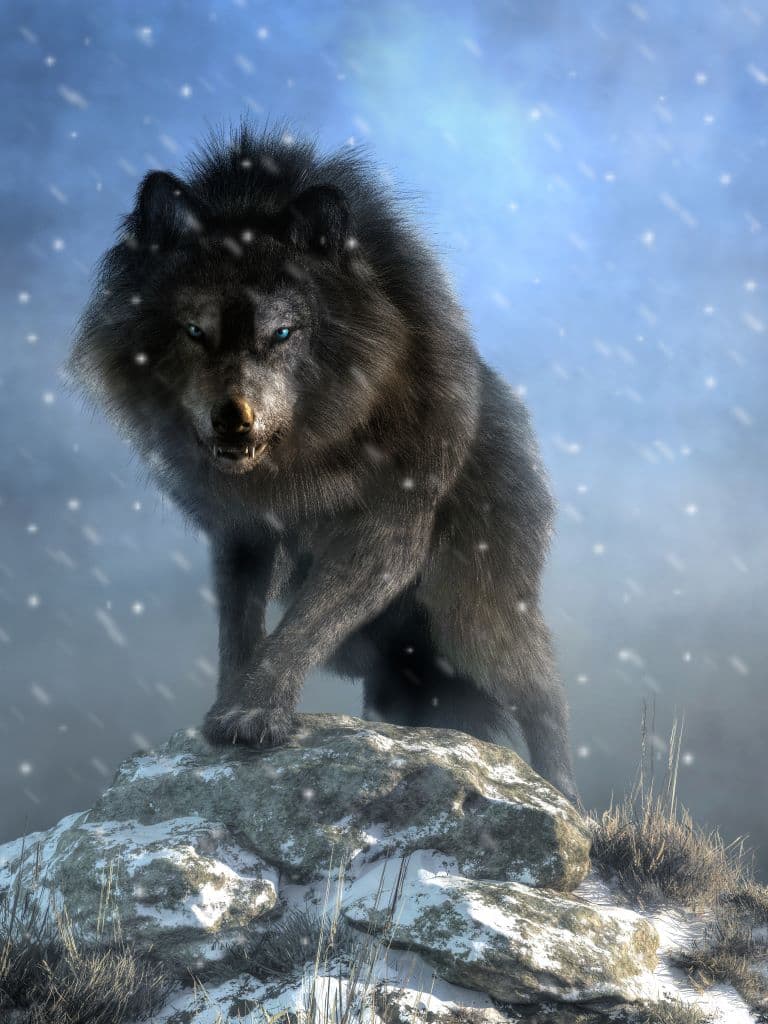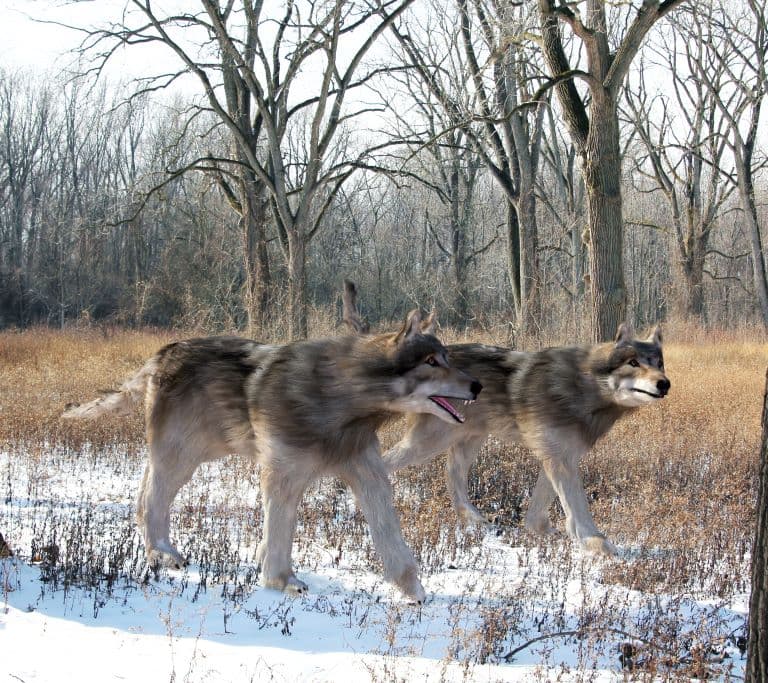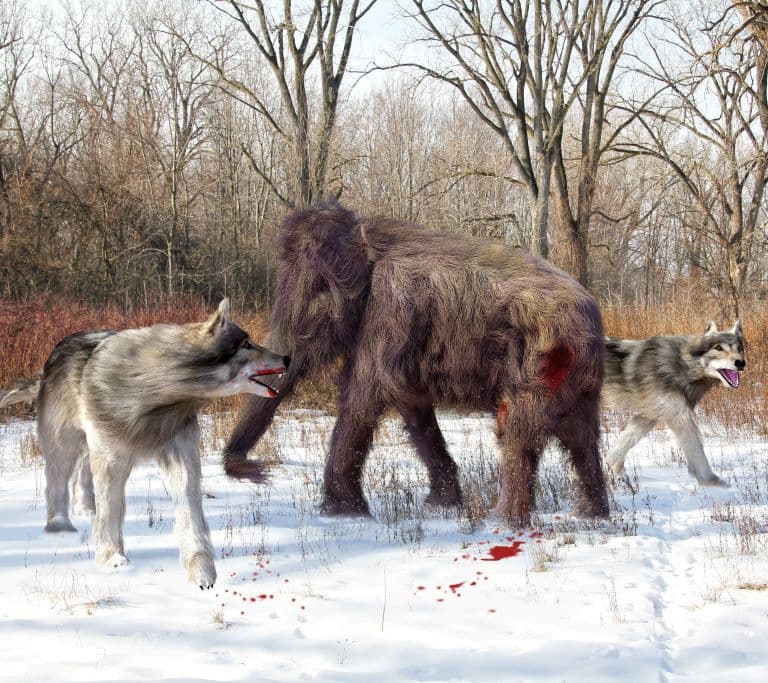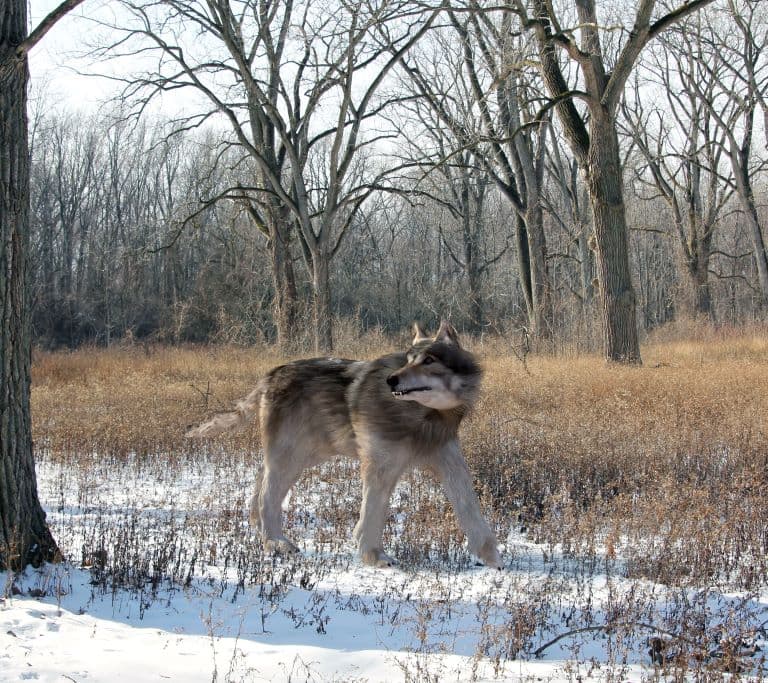Dire Wolf Profile
For some, this might be like discovering the unicorn was real. Of all the legendary animals of recent folklore, a giant wolf somehow seems the most relatable. And fortunately for us, the dire wolf, though not technically a wolf, was very much a character in our non-fictional history.

Dire Wolf Facts Overview
| Habitat: | Grassland, savanna, forest |
| Location: | North America, South America, East Asia |
| Lifespan: | Unknown |
| Size: | Around 1m (3ft) tall |
| Weight: | Up to 77kg |
| Color: | Unknown |
| Diet: | Large mammals |
| Predators: | None |
| Top Speed: | Unknown |
| No. of Species: | 1 known, likely more |
| Conservation Status: | Extinct |
These massive jackals roamed the Americas for hundreds of thousands of years, even spreading across the globe as far as China. They lived in a violent yet incredibly diverse environment with lots of enormous herbivores to eat.
However, they also had to compete with lots of enormous predators to get at them, and so were quite good at scavenging when they could. As such, most of their remains come from individuals trapped in tar pits in California.
Interesting Dire Wolf Facts
1. A terrible wolf
In the 1800s, remains of giant, extinct wolf-like animals started popping up all over the United States. These were all labelled different species by different people, and since they were dog-like, they were placed in the genus Canis, with modern wolves and dogs.
For a long time, all that showed up were bone fragments and it wasn’t until a whole skeleton showed up that it was possible to determine all these different specimens were in fact from the same species.
The palaeontologist who was first to recognise this also proposed a new genus for the animal, but nobody thought that was a very good idea and the dire wolf would remain misplaced until 2021, when its DNA would show us that he was right.
So, the genus Aenocyon was chosen, roughly translating from Greek to “terrible dog”, and the species dirus remains, compounding that Greek with the Latin equivalent: terrible dog, terrible.

2. And they were
Dire wolves had some serious competition. They competed for their lunch against the American lion, the giant short-faced bear and the Sabre-toothed tiger. So, they had to be tough. Despite looking a lot like modern wolves, they had significantly more power.
These were ‘wolves’ that would chase down wild horses to eat, and impart their will with the highest bite force of any placental mammal recorded.
Since these were social animals, this bite force wasn’t so much to kill quickly as it was to bring down large animals, so it’s assumed that a pack of these scary dogs could take on just about any of the Pleistocene megaherbivores of the time. 1
3. They were big
Dire wolves probably looked a lot like the modern grey wolf, at least in terms of the shape of their heads. But they had roughly 20% more mass and size. Their heads are the same shape as a grey wolf, hence the confusion, but their teeth are much larger and stronger, suggesting more shear force. 2 3
4. They were stocky
Unlike modern wolves, the dire wolf was powerfully-built. Modern wolves are built for endurance and will use their exceptional stamina to chase down heavier prey, but the dire wolf appears to be built for battle.
The canines were powerful but flexible, which allowed them to hold onto struggling prey for a long time, implying that their hunts would have been exhausting wars against far larger animals.

5. They were probably good scavengers
It’s recently come to everyone’s attention that the notorious scavengers hyenas are actually very accomplished hunters, and in fact, take most of their food this way. They just do it in the dark, when nobody’s watching, and are quite happy to scavenge during the day, which is how they developed their reputation.
It’s quite possible that dire wolves had a similar flexibility in their feeding methods, and the rate of fossil fragments found in tar pits backs this up. Countless thousands of bone fragments are pulled up from tar pits in California alone, at an abundance of over 100 times that of the grey wolf.
This suggests not only were they more prevalent than wolves, but they likely visited the pits to feast on the carcasses of dead animals like mammoths, who would routinely wander in and get stuck. Dire wolves, perhaps even entire families of them, would follow suit, sinking into the tar and becoming preserved for tens of thousands of years. 4
6. They’re not wolves
These tar pits also gave us the samples for the molecular analysis required to figure out what in the genetic lineage is going on with the taxonomy of this beast. Subfossil specimens from Idaho, Wyoming, Tennessee and Ohio provided researchers with enough DNA to assess the mitochondrial genomes of the dire wolf, and samples from the La Brea tar seeps in California provided collagen that was intact enough for sequencing.
Like DNA, collagen is made up of unique combinations of molecules that are encoded and passed
down through generations. These are essentially genetic fingerprints that are much more robust than DNA itself and can be used, through a process called zooarchaeology, to identify species in archaeological remains.
The results were surprising. Once thought to have diverged from grey wolves around 1.5 million years ago, the dire wolf was found to be far more distantly related: having separated closer to six million years prior.
Their closest extant relative, then, became the African jackal. But their populations overlapped with other canids at this time, so why didn’t they interbreed? 5
7. They kept to themselves
Coyotes and grey wolves and other such canids tend to mate with one another and produce hybrids.
This, if it were possible for dire wolves, should have resulted in a much closer genetic link between the species. It seems as though, despite sharing a space, the dire wolf wasn’t interested in, or wasn’t physically capable of hybridising with anyone else.
And this might have been why they’re no longer with us.

8. Megafaunal extinction sealed their fate
These powerful predators were well adapted to taking on large prey. And at the end of the ice age, 72% of megafauna went extinct. Most of these were the very giant herbivores that would have sustained dire wolf populations.
The change in climate, coupled with increased hunting pressure from humans drove most large mammals to extinction, and these factors would have been a lot harder to adjust to without being able to for a larger predator that can’t hybridise.
Healthy hybridisation allows animals like the grey wolf and coyote to develop various useful traits like better immune systems or sensitivity to oxygen. The larger, less genetically-flexible dire wolf may have died out as the last of its kind – as recently as 9500 years ago – because it wasn’t able to breed with its neighbours.
Dire Wolf Fact-File Summary
Scientific Classification
| Kingdom: | Animalia |
| Phylum: | Chordata |
| Class: | Mammalia |
| Order: | Carnivora |
| Family: | Canidae |
| Genus: | Aenocyon (Canis) |
| Species: | dirus |
Fact Sources & References
- W. Anyonge, A. Baker (2016), “Craniofacial morphology and feeding behavior in Canis dirus, the extinct Pleistocene dire wolf”, Zoological Society of London.
- Alexandria L. Brannick (2015), “Microevolution of Jaw Shape in the Dire Wolf, Canis dirus, at Rancho La Brea”, Science Series.
- William Anyonge (2010), “New body mass estimates for Canis dirus, the extinct Pleistocene dire wolf”, Journal of Vertebrate Paleontology.
- “Our Evolving Understanding of Dire Wolves”, Natural History Museum.
- Angela R. Perri (2021), “Dire wolves were the last of an ancient New World canid lineage”, Sci Hub.
